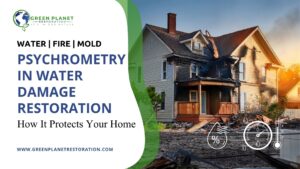Did you just discover a water leak soaking your drywall? Are you worried about mold growth and costly repairs coming your way? Water damage just doesn’t wait. Every hour that passes increases the risk of permanent drywall damage and dangerous mold growth. What starts as a small leak today can turn into thousands of dollars in repairs tomorrow if not handled properly. But here’s the good news: with the right water damage restoration company and quick action, you can save your drywall and prevent a full replacement. In this guide, you will discover the professional techniques to dry the drywall after a leak effectively. And learn exactly when replacement becomes necessary and how to prevent damage in future. Let’s get started.
Also read: The Role of Restoration Services in Mitigating Climate-Related Disasters
Why is it important to dry the drywall right away?
The difference between a simple fix and a major renovation project comes down to what you do in the next 24 hours. It is important to call a water damage restoration company immediately whenever you find water damage in your home or building. This will save time and costly repairs while preventing further damage. Next step is to turn off the power to avoid any electrical hazards. It is also very important to turn off the water source and call a local plumber, especially if the leak is continuous.
Also read: 24 Hour Plumbing Emergency Guide
Delaying this may lead to even more hazardous conditions – starting with mold growth. If water damage is extensive, mold spores (that are already in the air) will gather in the wet area and start eating the damaged drywall. That is why it is important to act fast and attempt to dry the drywall professionally.
Also read: How Truck Mounted Extractors Remove Water from Carpets
How to assess water damage to the drywall?
Now that you understand the urgency and importance of drying the drywall right away, it’s also equally important to assess water damage to drywall. However, in order to do so, we must evaluate a few factors first.
Also read: Should I File an Insurance Claim for Water Damage?
Initially, determine how long the drywall has been exposed to moisture, as mold growth starts quickly after 48 hours. Use a moisture meter to assess the moisture levels in the drywall; readings above 12% indicate dampness requiring attention.
Also consider the source and type of water that damaged the drywall. Clean water might be safe to handle, but if the water is contaminated, emergency sewage cleanup services might be required.
Also read: Flood Damage Cleanup vs. Sewage Damage Cleanup
Now examine the structural integrity. Has the solid structure behind the drywall been compromised? This is important, especially for ceilings, as there’s a risk of collapse. In case the drywall is sagging, crumbling, or soft, there is a possibility of structural damage.
Also read: How to Use a Submersible Pump for a Flooded Basement in Seattle
How to Dry Out Damaged Drywall?
To speed up the drying process, it’s best to remove the drywall so that it can dry on both sides. While you are setting up the drying tools, you might also want to remove any moldings, baseboards, or trim. Also, this will keep water and microbes from getting stuck between the materials and the wall. Of course, any wallpaper that is on walls that are drying should also be removed.
Also read: Leaking Ice Makers: Why They Happen and How to Prevent Them
Now set up the drying equipment and aim at increasing the airflow inside the covered area. If the weather permits, open all of your outside windows and doors to let more air flow through. Then, set up the fans and dehumidifiers to help dry the drywall. The purpose is to extract the moisture by moving air around it.
Did sewage or floodwater soak into your drywall? Learn Why You Must Replace Sewage-Damaged Drywall And How to Do It
Drying time for drywall can vary, but typically it takes between 3 to 5 days. Professional water damage restoration companies are equipped with industrial-grade axial fans and LGR dehumidifiers to speed up the drying process. These Low Grain Refrigerant (LGR) dehumidifiers are absolutely necessary for water-damaged areas. They utilize a two-stage cooling system and superior heat exchange to prevent secondary damage by effectively removing humidity, even in low humidity conditions.
Learn more: How LGR Dehumidifiers Prevent Secondary Damage
Preventing Water Damage in the Future
Prevention is often the best course of action. Here are methods to prevent future water damage and protect your drywall:
- Regular Inspections: Conduct routine checks around potential leak points, such as under sinks and within the attic, to detect issues early.
- Maintain Gutters: Clean gutters frequently to prevent overflow that can lead to leaks and subsequent water damage.
- Seal Foundation Cracks: Properly sealing your home’s foundation can prevent water infiltration and protect basement areas.
- Install Water Alarms: Early alert systems help detect leaks before significant damage occurs, providing timely intervention.
Also read: What Does Certified Mold Testing Do?
Need Professional Help? Trust Green Planet Restoration Seattle.
Water damage to your drywall can become a serious threat to your home’s structural integrity and your family’s health. If you are dealing with contaminated water, hidden moisture, or signs of structural weakness, it’s time to call in the experts. The Seattle water damage restoration experts at Green Planet Restoration are ready to help 24/7. In our water damage restoration process we use industrial-grade equipment and proven techniques to dry the drywall after a leak, and also repair and restore your home – fast. Call us at (425) 903-3133 now for emergency service. Your drywall and your peace of mind are worth protecting! Act fast before the damage gets worse.
Also read: How To Handle Flood Damage in Southern California
___________________
Related Posts
Complete Guide to Crawl Space Maintenance and Cleanup
24 Hour Plumbing Emergency Guide
How LGR Dehumidifiers Prevent Secondary Damage
How Moisture Meters Prevent Mold Growth
Leaking Ice Makers: Why They Happen and How to Prevent Them
How To Handle Flood Damage in Southern California
Should I File an Insurance Claim for Water Damage?
8 Common Causes of Household Water Leaks and Water Damage
Psychrometry in Water Damage Restoration: How It Protects Your Home
Pin vs Pinless Moisture Meters: What’s the Most Accurate Moisture Meter for Walls?










